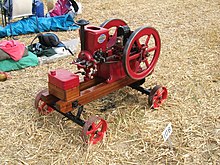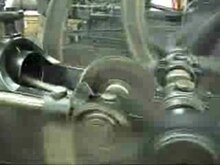Dropout regulation
The misfire control is a method to control the speed and thus the power output of reciprocating piston engines in partial load operation . It was mainly used in four-stroke gas and gasoline stationary engines in the late 19th and early 20th centuries, mainly by Anglo-American manufacturers, where these engines are referred to as "hit-and-miss engine" .
functionality
The throttling of the power in these engines did not take place through a continuous, quantitative regulation of the amount of the fresh gas mixture sucked in by a throttle valve or a similar actuator in the intake tract, but through targeted "dropping out" of work cycles by influencing the valve control times on a case-by-case basis Speed controller was triggered. The low-speed single cylinders were fitted with large flywheels in order to be able to bridge the idle strokes in regular operation.
When a specified maximum speed was exceeded, a mechanism was activated that decoupled the exhaust valve from the valve train in such a way that it remained in the open position. On the one hand, this led to the fact that no negative pressure was generated in the cylinder during the intake stroke, as a result of which the intake valve designed as a sniffing valve remained closed and no fresh gas mixture was drawn in. The consequence of this was that the Otto cycle was interrupted despite continuously continued piston strokes due to a lack of cylinder filling and compression - at least for this work cycle - and so no ignition and therefore no power generation took place. In addition, the open exhaust valve reduced the compression work during the compression stroke, which in conjunction with the large flywheel made it easier to continue running until the next stroke.
If the control speed was not reached again after one or more idle stroke revolutions, the exhaust valve carried out a regular stroke again, which resulted in a work cycle with ignition that accelerated the crankshaft again. Likewise, designs were common in which the positively controlled inlet valve in this case remained in the closed position during the suspended cycle, which achieved a comparable effect. In full-load operation, the engine run did not differ from a conventional engine within the control bandwidth; the work cycles were then carried out continuously without misfires.
Due to the fluctuating speed in normal operation, this control is not suitable for applications that require a constant speed even in the partial load range with low power consumption.
With misfire control, the machine always works with the maximum cylinder charge, i.e. with the highest degree of efficiency, when ignitions take place. Since the inlet valve remains closed when the cycles are skipped, no fresh gas is sucked in during these phases and therefore no fuel is consumed. This distinguishes the misfire control from the unintentional misfiring of conventional gasoline engines due to defective ignition systems or spark plugs, in which fuel is sucked in and discharged unburned and thus wasted. Likewise, the - meanwhile technically outdated - rev limiters with ignition interruption by centrifugal switch in older carburettor engines have a different operating principle, since only the ignition was interrupted here, but not the cylinder filling with fresh gas.
The misfire control is also used in modern internal combustion engines . The efficiency of the engine is increased by switching off individual cylinders.
Web links
Individual evidence
- ↑ Explanation of the functionality on schlueter-oldtimer.de based on a Schlüter Bavaria "B"
- ↑ Deutz CM / CM2 series ( Memento from June 10, 2015 in the Internet Archive )
- ↑ Karl Albrecht, Gottlieb D. Jerie: Motors - Göpel u. Wind motors, water wheels, etc. Turbines, internal combustion engines . In: Uhland's handbook for the practical machine designer , Volume 5, Loewenthal, Berlin 1915, p. 138 ff. ( Google Books Snippet )
- ↑ Heating and cooling technology, Volume 43, Issue 3 - Volume 45, Issue 3 , Berlin 1941, p. 148 ( Google Books Snippet )
- ↑ Valve train with cam switching for the gas exchange valves of a 4-stroke internal combustion engine , patent application

